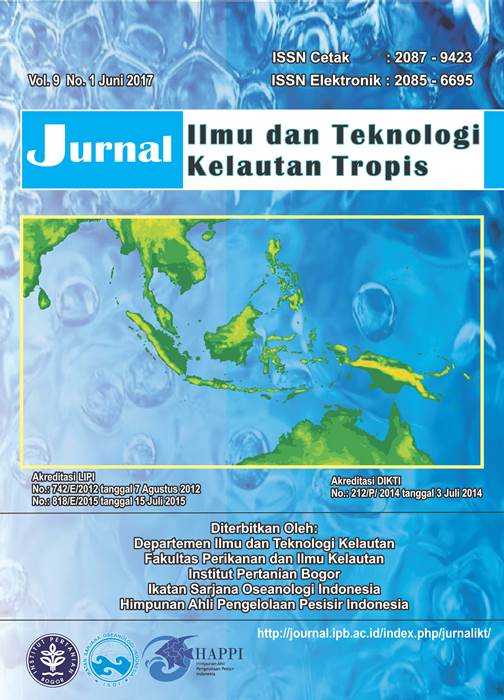CORAL REEF ECOSYSTEM VULNERABILITY INDEX TO OIL SPILL: CASE OF PRAMUKA ISLAND AND BELANDA ISLAND IN SERIBU ISLANDS
Abstract
Vulnerability analysis is one of the methods for determining effective management of coastal and marine resources. Seribu islands potentially affected due to oil spills. The oil spills incident in this area caused by shipwreck from traffic on Tanjung Priok port and ALKI 1, as well as accident of petroleum exploration and exploitation. At least, oil spills in Seribu Islands have been recorded since 2003, 2004, 2006, 2007 and 2008. This study aims to calculate the vulnerability index of Pramuka island and Belanda island in the Seribu Islands. This research was conducted by using a theoretical approach of vulnerability (V), which is a function of exposure (E), sensitivity (S) and adaptive capacity (AC). The parameters in exposure category are tidal type, tidal range, wave height, substrat type, and water depth. Parameters in sensitivity category are growth type of reef, slope, protected ecosystem, coverage percentage, coral density, protected species, and fish abundance. Parameters in adaptive capacity are oil spill contingency system, conservation institution, community response, and economic dependence. Data of each parameter were transformed into a score ranging from 1 to 5. The formula of vulnerability index using addition and subtraction model where; V = E + S – AC. The results indicate that Seribu Islands have vulnerability status from moderate to high, which 4.15 for Pramuka island and 6.39 for Belanda island.
Keywords: vulnerability index, Seribu islands, coral reef, oil spill
Authors
This work is licensed under a Creative Commons Attribution 4.0 International License.
Jurnal Ilmu dan Teknologi Kelautan Tropis i is an open-access journal, meaning that all content is freely available without charge to the user or their institution. Users are allowed to read, download, copy, distribute, print, search, or link to the full texts of the articles in this journal without needing to request prior permission from the publisher or the author.
All articles published by Jurnal Ilmu dan Teknologi Kelautan Tropis are licensed under the Creative Commons Attribution 4.0 International License. This allows for unrestricted use, distribution, and reproduction in any medium, provided proper credit is given to the original authors.
Authors submitting manuscripts should understand and agree that the copyright of published manuscripts is retained by the authors. Copyright encompasses the exclusive rights of authors to reproduce, distribute, and sell any part of the journal articles in all forms and media. Reproduction of any part of this journal, its storage in databases, and its transmission by any form or media is allowed without written permission from Jurnal Ilmu dan Teknologi Kelautan Tropis.


